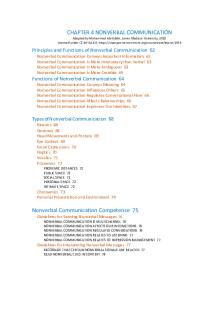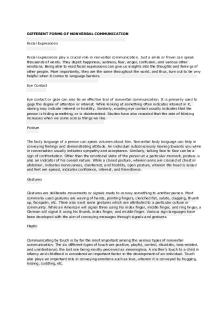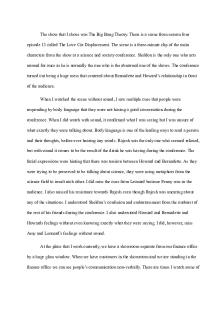WEEK 6 Different Forms OF Nonverbal Communication PDF

| Title | WEEK 6 Different Forms OF Nonverbal Communication |
|---|---|
| Course | English for Professional Interaction |
| Institution | Universiti Teknologi MARA |
| Pages | 2 |
| File Size | 55.2 KB |
| File Type | |
| Total Downloads | 47 |
| Total Views | 161 |
Summary
note...
Description
DIFFERENT FORMS OF NONVERBAL COMMUNICATION Facial Expressions
Facial expressions play a crucial role in nonverbal communication. Just a smile or frown can speak thousands of words. They depict happiness, sadness, fear, anger, confusion, and various other emotions. Being able to read facial expressions can give us insights into the thoughts and feelings of other people. More importantly, they are the same throughout the world, and thus, turn out to be very helpful when it comes to language barriers. Eye Contact
Eye contact or gaze can also be an effective tool of nonverbal communication. It is primarily used to gage the degree of attention or interest. While looking at something often indicates interest in it, staring may indicate interest or hostility. Similarly, evading eye contact usually indicates that the person is hiding something, or is disinterested. Studies have also revealed that the rate of blinking increases when we come across things we like. Posture
The body language of a person can speak volumes about him. Nonverbal body language can help in conveying feelings and demonstrating attitude. An individual subconsciously leaning towards you while in conversation usually indicates sympathy and acceptance. Similarly, talking face to face can be a sign of confrontation. Other than the emotional state of the person at a particular moment, posture is also an indicator of his overall nature. While a closed posture, wherein arms are crossed at chest or abdomen, indicates nervousness, disinterest, and hostility, open posture, wherein the head is raised and feet are spread, indicates confidence, interest, and friendliness. Gestures
Gestures are deliberate movements or signals made to convey something to another person. Most commonly used gestures are waving of hands, pointing fingers, clenched fist, salute, clapping, thumb up, facepalm, etc. There also exist some gestures which are attributed to a particular culture or community. While an American will signal three using his index finger, middle finger, and ring finger, a German will signal it using his thumb, index finger, and middle finger. Various sign languages have been developed with the aim of conveying messages through signals and gestures. Haptic
Communicating by touch is by far the most important among the various types of nonverbal communication. The six different types of touch are positive, playful, control, ritualistic, task-related, and unintentional; the last one being mostly perceived as meaningless. A mother's touch to a child in infancy and childhood is considered an important factor in the development of an individual. Touch also plays an important role in conveying emotions such as love, wherein it is conveyed by hugging, kissing, cuddling, etc.
Paralanguage
Paralanguage is indeed vocal communication, but it's different from normal spoken language. A sigh and gasp are by far the best examples of the same. The tone, pitch, and softness/loudness of the voice are the prominent aspects of paralanguage. A strong tone indicates the confidence level, while a hesitant tone indicates lack of confidence or lack of interest. Similarly, sounds like 'uh-huh', 'aha' and 'ahem' also offer nonverbal cues to your behavior. Proxemics
Proxemics is primarily based on the amount of personal space we need or maintain when we indulge in any sort of activity. This can be attributed to various factors including social norms, familiarity with the other person, and personal characteristics of an individual. The amount of space between two people in conversation most often indicates their closeness (or the lack of it) to each other. Roughly about 1.5 ft of space around an individual is considered his intimate space, 4 ft his personal space, 12 ft his social space, and 25 ft is the public space. Appearance
Additionally, some sources also add appearance to the list. Regardless of whether you are addressing a group of people or interacting with someone for the first time, your audience has already made some assumptions about you based on your appearance. And if you fail them in this aspect, they may not even pay attention to what you have to say. When we say appearance, it includes your clothing as well as personal hygiene. In fact, appearance has a crucial role to play in first impressions, and yet, it is one of the most neglected attributes of nonverbal communication. It is difficult to fake nonverbal communication as there are numerous signals involved. Same is the case with the interpretation part. You are likely to miss out on nonverbal cues if you are not paying attention. On the other hand, by paying attention to these cues and sending across the right signals, you will be able to ensure that your interaction with the other person is smooth sailing. Read more at Buzzle: http://www.buzzle.com/articles/types-of-nonverbal-communication.html...
Similar Free PDFs

6 - Nonverbal Communication
- 1 Pages

Chapter 4 Nonverbal Communication
- 19 Pages

CH 5 HW: Nonverbal Communication
- 2 Pages

Week 6 Week 6 Week 6Week 6
- 2 Pages
Popular Institutions
- Tinajero National High School - Annex
- Politeknik Caltex Riau
- Yokohama City University
- SGT University
- University of Al-Qadisiyah
- Divine Word College of Vigan
- Techniek College Rotterdam
- Universidade de Santiago
- Universiti Teknologi MARA Cawangan Johor Kampus Pasir Gudang
- Poltekkes Kemenkes Yogyakarta
- Baguio City National High School
- Colegio san marcos
- preparatoria uno
- Centro de Bachillerato Tecnológico Industrial y de Servicios No. 107
- Dalian Maritime University
- Quang Trung Secondary School
- Colegio Tecnológico en Informática
- Corporación Regional de Educación Superior
- Grupo CEDVA
- Dar Al Uloom University
- Centro de Estudios Preuniversitarios de la Universidad Nacional de Ingeniería
- 上智大学
- Aakash International School, Nuna Majara
- San Felipe Neri Catholic School
- Kang Chiao International School - New Taipei City
- Misamis Occidental National High School
- Institución Educativa Escuela Normal Juan Ladrilleros
- Kolehiyo ng Pantukan
- Batanes State College
- Instituto Continental
- Sekolah Menengah Kejuruan Kesehatan Kaltara (Tarakan)
- Colegio de La Inmaculada Concepcion - Cebu











